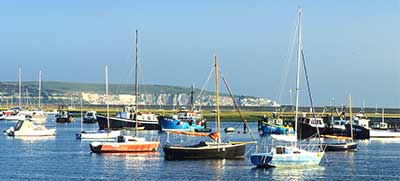Wild flowers of Keyhaven, Pennington, Normandy and Hurst
Wild flower enthusiasts will find much to admire around Keyhaven, Pennington Marshes, Normandy Marshes and Hurst Spit. Almost unparalleled habitat diversity almost guarantees the presence of a widely varied flora including, not surprisingly, many salt-tolerant species.
(1) Away from the shore
Before giving the 'salties' pride of place, let's mention some of the typically present 'non-coastal' species to be found, starting with common gorse, which is a shrub really, rather than a wild flower, but its blooms are so conspicuously colourful that it just has to be included.
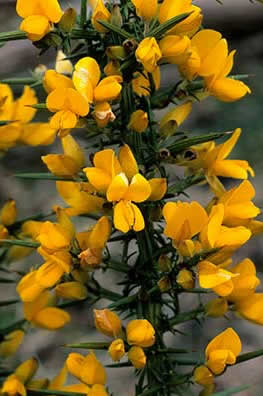
Indeed, gorse flowers can be seen to greater or lesser extent all the year round, so-much-so that, according to an old country saying, 'kissing is out of fashion whenever gorse is not in bloom'. The main flowering season, however, is in March and April, when gorse breaks become swathed in a conspicuous mass of golden yellow.
Here gorse is perhaps most prominent in the area behind the sea-wall at Iley Point, where Dartford warblers often find refuge and foodstuffs, and so, too, do linnets and occasional stonechats.
Similarly, blackthorn is also widely present, conspicuously so in late winter and early spring when the brilliant white flowers light up the Ancient Highway before equally abundant hawthorns a little later put on a similar show. Both, of course, also deliver colour in the autumn - blackthorns with deep purple sloes and hawthorns with scarlet red berries - and feasts for autumn and winter visiting redwings and fieldfares, and also for resident thrushes and other birds.
Elsewhere, along the lanes and in scattered copses are bluebells, lesser celandines, birds foot trefoil, haresfoot clover, plantains, common dog violet, sweet violet, cow parsley, hogwort, ragwort and many more species.
(2) The damper grasslands

The brilliant yellow flowers of marsh marigolds brighten the ditches and so do the intricate white blooms of the much under-stated bog beans and the drooping, purplish-pink bell-shaped flowers of water avens, nodding gently in the breeze.
Reeds, rushes and sedges abound and enthusiasts might even stumble across wild celery and parsley water-dropwort.
From April to June, look out, too, in the damper places for the delicate pink blooms of lady's smock, which is perhaps better known as cuckoo flower, so named because our forebears noticed their appearance at around the same time as the annual influx of cuckoos.
Another old Hampshire name, with similar derivation, was nightingale flower, although sadly, the sound of the nightingale is now rarely heard when the plant is in bloom or at any other time of year.
These charming perennials are much loved by orange tip butterflies, insects whose flight period coincides almost exactly with the plants' flowering period - they lay their eggs on their caterpillars' food-plants and, of course, lady's smock is a favourite.
(3) A selection of salt-tolerant species
But it is the species with a primarily coastal distribution, and particularly those that are markedly salt-tolerant, that provide much that is different to the plants found just a little way inland.
Take the oddly named Alexanders, for example. A quite tall, yellow flowered umbellifer, a member of the carrot family, it is a native of Macedonia, home of Alexander the Great! It is a biennial plant that typically grows on cliffs, in hedge-banks, on waste ground and in similar habitats, but most often near the sea.
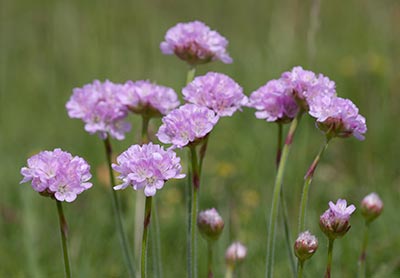
Then there is sea pink, or thrift as it is often known, a plant that grows well in infertile soil and produces pretty pink blooms from May until July. It can tolerate a large proportion of salt in the soil and is commonly found on coastal cliffs and salt marshes, although well-established populations also exist on mountain tops in the Lake District, Scotland and western Ireland.
Although a typical inhabitant of Hurst Spit, sea pinks can also be found rooted in nooks and crannies along the seawall. They are closely related to the similarly coloured sea lavender that is more typically found in the salt marsh, blooming from July to September.
Sea campion - similar to the more common and very familiar red campion, but with white blooms that can cause identification confusion with bladder campion - grows on sea cliffs and amongst shingle, which almost makes presence predictably inevitable on Hurst Spit. Also found growing along the seawall, it flowers from May until September.
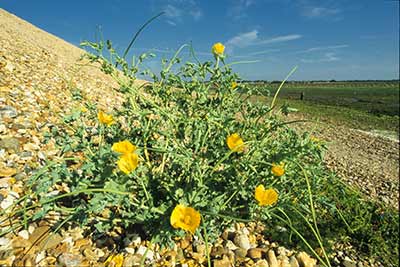
Yellow horned-poppies are also Hurst Spit regulars, striking sea shore inhabitants that can also sometimes be found growing inland. Covered in fine hairs to help prevent them from drying out in the arid, shingle substrate in which they are often found, yellow horned-poppies are by far the most colourful sea shore plants, producing large, bright yellow blooms during the long, June to October flowering season.
Sea purslane, a plant typically found around the deep, muddy creeks that cut through the salt-marsh, like many of the other species is a tough cookie that has to tolerate high concentrations of salt around its roots and can be subjected to inundation by the tides.
Growing up to 0.75 metres (30 inches) in height, its yellow flowers appear from July to September, but it is its silvery foliage that perhaps attracts most attention - the sheen caused by minute papery scales that hold moist air that provides protection from the drying effects of salt water.
(4) Other sea shore specialists
Other sea shore specialists have fascinating stories to tell of former use in the home, in industry and even in the Royal Navy.
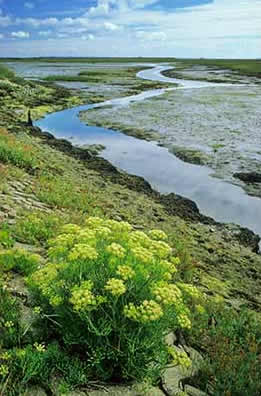
Rock samphire, for example, is another species with moisture retaining, fleshy leaves. An umbellifer closely related to Alexanders, it is most often noticed locally growing on the sea-wall, although it is equally at home amongst shingle and on cliff faces and other rocky places.
Its conspicuous yellow flowers appear from July to October. In days-gone-by, the thick, fleshy leaves and stalks were popular as edible vegetables that additionally were said to aid digestion and relieve kidney stones.
Indeed, in an 1866 account of food served during local festivities held annually includes: 'Freshly culled samphire, from around the saltings, proved a welcome garnish.'
Marsh samphire, or glasswort, is primarily a salt marsh plant. A fleshy annual with inconspicuous greeny-yellow flowers that are present in August and September, in structure it resembles a low-growing, non-spiky cactus.
Its succulent, scale-like leaves, though green in summer, take on glorious reddy autumnal hues that add welcome splashes of colour around the lagoons and in the marshes. Like the other samphires, it is edible, but unlike them, after burning, its ash, which is rich in soda, was used in the manufacture of glass - hence the name.
(Golden samphire, a yellow flowered, fleshy leaved plant found around Hurst Castle, is, in contrast, a member of the daisy family - it is unrelated to its rock and marsh namesakes although it shares a liking for similar habitats to rock samphire, hence the name - 'samphire' refers to growth around rocks.)
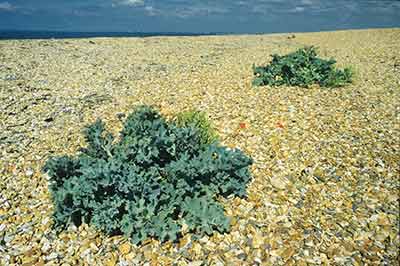
Hummock-like sea kale, an impressively large, hardy, deep rooted member of the cabbage family with fleshy, edible leaves, can be found growing in the shingle on Hurst Spit, a home it shares with sea beet, another plant that forms quite large clumps.
Possessed of a stout, sugar rich taproot, variants of sea beet include beetroot, sugar-beet, fodder-beet and spinach beet. Indeed, on the Isle of Wight, and maybe in other places, too, inhabitants apparently ate the leaves, boiled, and referred to the plant as sea spinach or wild spinach. Cultivation seemingly started around 2,000 years ago in the Middle East, with the aim of breeding strains with larger, fleshier roots and more nourishing leaves. An erect or sprawling perennial, its stems can be up to 1 metre (a little over 3 feet) long.
English scurvygrass, not a particularly attractive sounding plant, is a low to medium height perennial that grows in muddy, tidal salt-marshes and produces white or pale mauve flowers from April until July.
Danish scurvygrass, meanwhile, also found locally, is an inhabitant of sea-wall turf, shingle, and sandy beaches, although oddly, it has also spread inland along roadside verges - cars and other vehicles are thought to have been inadvertently responsible for distributing the seeds, whilst winter road salting has created suitable habitat.
The leaves of both species are rich in vitamin C and when regularly eaten, prevent scurvy, a particularly unpleasant disease that afflicted early sailors during long ocean voyages and also people on land whose diet lacked this essential vitamin.
And finally, as a further example, sea sandwort, a low growing perennial that rarely attains a height of more than 15 centimetres (6 inches), in places carpets patches of ground amongst the shifting stones of Hurst Spit, adding a bright, glossy green covering embellished from May to September by tiny white flowers. Despite its small stature, the succulent leaves used to be pickled and eaten.
(5) Summer and early autumn colour
Salt-marsh colour is provided from mid-summer until early autumn by common sea-lavenders, conspicuous salt-marsh inhabitants that bloom from July until September, and sometimes later.
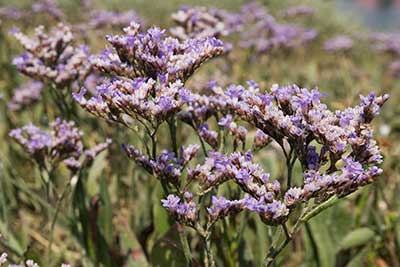
Quite short or medium height perennials, they can be seen growing, sometimes in profusion, right the way along this stretch of coast. Lilac / lavender hued flowers are tightly packed in flat-topped clusters at the end of the stalks, adding welcome splashes of colour to the landscape.
Also known in the past as marsh lavender, the plant's seeds were apparently employed against a whole range of ailments including colic, dysentery, strangury - a very unpleasant-sounding condition caused by blockage or irritation at the base of the bladder - and fluxes of the blood.
Sea asters, close relatives of the more familiar Michaelmas daisy and in many regards of similar appearance, are also late bloomers. And as with Michaelmas daisies, sea asters are said to be at their best around St. Michael's Day - September 29th - when swathes of salt-marsh and local ditches take on a bluey / purple tinge.
Quite unlike Michaelmas daisies, though, sea asters have very fleshy leaves which aid the retention of fresh water.
Parking
'Pay and Display' parking is available in the centre of Keyhaven, opposite The Gun Inn. A limited amount of short stay - up to 4 hours - free parking is available beside the seawall on the road leading past the Avon Water outflow, but space here is at a premium. Further limited parking is available at the end of Lower Pennington Lane. Roadside parking is available close to Hurst Spit, beside New Lane and Saltgrass Lane; and parking is also available at the Lymington end of the seawall path.
References:
The Flora of Hampshire: Anne Brewis, Paul Bowman and Francis Rose
Secret Marsh: Aimee Durnell
One man's marshes - the birds of Lymington and Keyhaven: Ed Wiseman
Lymington-Keyhaven Report 2010
Quick links
More links
Search this site

